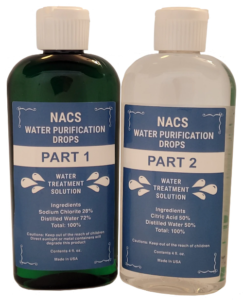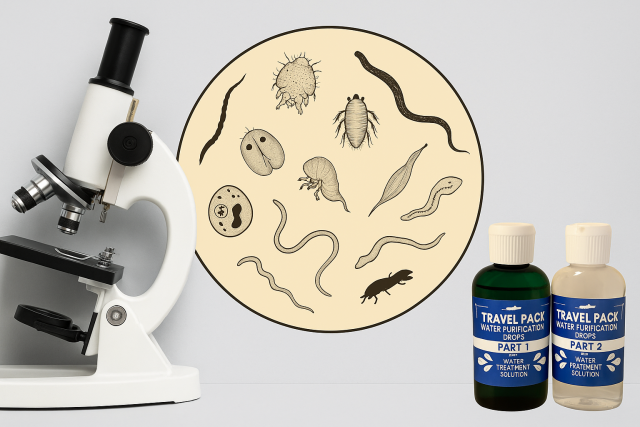Parasites, organisms that live in or on a host and feed at its expense, have affected human health since ancient times. They can inhabit the skin, eyes, digestive tract, bloodstream, or organs, causing symptoms ranging from mild irritation to life-threatening disease. Many individuals have reported success using chlorine dioxide, a water purification agent, to neutralize a wide range of parasitic infections, from microscopic protozoa to large intestinal worms, through its oxidative detoxification mechanism.
Chlorine dioxide (ClO₂) is a selective oxidizer. It seeks out and neutralizes harmful pathogens, viruses, fungi, and parasites by breaking down their cell walls and disrupting their metabolic processes without damaging human tissue when used in diluted quantities.
How Does Chlorine Dioxide Eliminate Our Parasitic Infections?
Below is a detailed overview of the most common parasitic infections and how chlorine dioxide has been reportedly used by individuals seeking alternative methods of detoxification and healing.
1. Malaria (Plasmodium spp.)
Type: Protozoan blood parasite
Transmission: Mosquito bites (Anopheles species)
Symptoms: Cyclic fevers, chills, fatigue, anemia, and sweating.
How Chlorine Dioxide Works:
Reports suggest that chlorine dioxide may oxidize the heme component of the parasite’s metabolism, interrupting its ability to reproduce within red blood cells. Jim Humble’s early work with malaria in Africa reported full symptom resolution within hours of treatment using activated chlorine dioxide drops.
Suggested Use (as reported by others):
Activated MMS/CDS taken orally per Protocol 1000 (3 activated drops/hour in water for 8 hours daily). In severe cases, Protocol 1000+ has been used under close self-monitoring.
2. Scabies (Sarcoptes scabiei)
Type: Parasitic mite infestation of the skin
Transmission: Direct skin contact or sharing infested clothing/bedding.
Symptoms: Intense itching, burrow tracks, rash, and secondary infection.
How Chlorine Dioxide Works:
ClO₂’s strong oxidizing nature helps destroy mites and their eggs on contact and disinfects secondary bacterial infections.
Suggested Use:
Apply diluted chlorine dioxide solution (1–2 activated drops per ounce of water) topically to affected skin twice daily; wash bedding and clothing in a mild ClO₂ rinse.
3. Lice (Pediculosis)
Type: Ectoparasitic insect (head, body, or pubic lice)
Transmission: Close physical contact or shared combs, hats, or bedding.
Symptoms: Itching, scalp irritation, and visible nits (eggs).
How Chlorine Dioxide Works:
It oxidizes and dehydrates lice and their eggs while sanitizing the scalp to prevent reinfestation.
Suggested Use:
Apply a diluted solution (1 drop ClO₂ per ounce of water) to the scalp, leave for 5 minutes, rinse thoroughly; repeat daily for 3–5 days.
4. Demodex Mites (Demodex folliculorum & D. brevis)
Type: Microscopic mites in hair follicles and sebaceous glands
Transmission: Skin-to-skin contact, contaminated bedding or towels.
Symptoms: Facial itching, redness, eye irritation, and acne-like eruptions.
How Chlorine Dioxide Works:
Chlorine dioxide helps oxidize and denature mite exoskeletons while cleansing clogged pores.
Suggested Use:
Dilute one drop of activated chlorine dioxide per ounce of distilled water. Apply gently with a cotton ball to the face nightly for one week.
5. Cat Scratch Fever (Bartonella henselae)
Type: Bacterial infection transmitted by cat scratches (parasite-associated)
Transmission: Cat scratches, bites, or fleas.
Symptoms: Swollen lymph nodes, fever, fatigue, and muscle aches.
How Chlorine Dioxide Works:
Though bacterial in origin, Bartonella behaves like a parasitic infection within red blood cells; chlorine dioxide can oxidize intracellular pathogens.
Suggested Use:
Protocol 1000 orally; topical application to scratches with a 10–20 ppm ClO₂ solution.
6. Creeping Eruption (Cutaneous Larva Migrans)
Type: Hookworm larvae migration under the skin
Transmission: Contact with contaminated soil (bare feet, beach sand).
Symptoms: Itchy, winding skin tracks.
How Chlorine Dioxide Works:
ClO₂’s surface oxidation may destroy larvae at the skin level while preventing secondary infections.
Suggested Use:
Topical 1–2 drop/oz solution applied 2–3 times daily.
7. Rickettsia (Rickettsial Infections, e.g. Typhus, Spotted Fever)
Type: Obligate intracellular bacteria transmitted by ticks, fleas, lice
Transmission: Tick, flea, or lice bites.
Symptoms: Fever, rash, muscle pain, headache.
How Chlorine Dioxide Works:
ClO₂ can oxidize infected blood components, supporting the immune system’s clearance of intracellular pathogens.
Suggested Use:
Protocol 1000 orally; in advanced cases, Protocol 2000 (up to 6 drops/hour, 8 hours daily).
8. Giardiasis (Giardia lamblia)
Type: Flagellated protozoan
Transmission: Contaminated water, food, or oral–anal contact.
Symptoms: Diarrhea, bloating, gas, greasy stools, fatigue.
How Chlorine Dioxide Works:
Destroys the cyst form of Giardia in the intestinal tract by oxidation, as demonstrated in water purification tests.
Suggested Use:
Protocol 1000 orally for 14–21 days; maintain hydration and probiotic support.
9. Amebiasis (Entamoeba histolytica)
Type: Protozoan intestinal parasite
Transmission: Contaminated food or water, poor sanitation.
Symptoms: Bloody diarrhea, abdominal pain, liver abscess.
How Chlorine Dioxide Works:
Oxidizes and destroys amoebic trophozoites, neutralizing cysts that cause relapse.
Suggested Use:
Administer Protocol 1000 orally for 3–4 weeks; in severe liver cases, supplement with a topical application over the liver region (10–20 ppm solution).
10. Schistosomiasis (Bilharzia)
Type: Blood fluke (trematode)
Transmission: Contact with contaminated freshwater (larvae penetrate skin).
Symptoms: Abdominal pain, bloody urine/sperm/stool, liver enlargement. Chronic conditions can affect the genital tract and increase vulnerability to other STIs, including HIV.
How Chlorine Dioxide Works:
Breaks down adult worm enzymes and inhibits egg development in blood vessels.
Suggested Use:
Protocol 1000+ orally for 3–6 weeks; regular bathing in diluted ClO₂ solution (5 ppm) may support skin disinfection.
11. Soil-Transmitted Helminths (Roundworm, Whipworm, Hookworm)
Type: Intestinal nematodes
Transmission: Fecal contamination, walking barefoot on infected soil.
Symptoms: Fatigue, malnutrition, intestinal discomfort, and anemia.
How Chlorine Dioxide Works:
ClO₂ neutralizes larval forms in the gut and oxidizes toxins released during parasite die-off.
Suggested Use:
Protocol 1000 orally, paired with enemas using 10–15 ppm solution 2–3 times per week.
12. Toxoplasmosis (Toxoplasma gondii)
Type: Intracellular protozoan
Transmission: Undercooked meat or contact with cat feces.
Symptoms: Fatigue, headaches, muscle aches, eye issues; dangerous for pregnant women.
How Chlorine Dioxide Works:
Chlorine dioxide supports immune elimination by oxidizing intracellular forms and reducing systemic inflammation.
Suggested Use:
Protocol 1000 orally for 21 days; topical ClO₂ eye rinse (very mild, 1 ppm) only under expert guidance.
13. Trichomoniasis (Trichomonas vaginalis)
Type: Protozoan sexually transmitted parasite
Transmission: Sexual contact.
Symptoms: Vaginal or urethral irritation, discharge, odor.
How Chlorine Dioxide Works:
Destroys protozoa in mucous membranes, disinfecting and balancing pH.
Suggested Use:
Oral Protocol 1000 plus gentle douche (1 drop per 4 oz water) once daily for 3 days.
14. Chagas Disease (American Trypanosomiasis)
Type: Trypanosoma cruzi (protozoan)
Transmission: Kissing bug (triatomine bugs) feces enter the eyes, mouth, or broken skin. They live in cracks in walls or roofs, animal nests, dog kennels, chicken coops, under porches, rocks, or brush piles.
Symptoms: Swelling near the bite, fever, chronic heart and digestive complications, can cause sudden death if untreated.
How Chlorine Dioxide Works:
Oxidizes parasite stages in blood and tissues, helping reduce toxic load.
Suggested Use:
Protocol 1000 orally for 30 days; topical ClO₂ application on bite site (1–2 drops/oz solution).
15. Leishmaniasis
Type: Protozoan transmitted by sandfly bites
Transmission: Sandfly bites.
Symptoms: Skin ulcers, fever, spleen enlargement (visceral type).
How Chlorine Dioxide Works:
May oxidize amastigote forms in tissues and aid immune recognition.
Suggested Use:
Oral Protocol 1000 plus topical ClO₂ on lesions (5–10 ppm solution).
16. Lymphatic Filariasis (Elephantiasis)
Type: Filarial nematode infection
Transmission: Mosquito bites transmit filarial larvae.
Symptoms: Lymph swelling, thickened skin, and disfigurement.
How Chlorine Dioxide Works:
Chlorine dioxide supports detoxification and reduces microfilariae count through oxidation of circulatory parasites.
Suggested Use:
Administer Protocol 1000 orally for 4–6 weeks; bathing with 5–10 ppm ClO₂ water may relieve swelling and sanitize the skin.

Mechanism of Action: How Chlorine Dioxide Affects Parasites
Oxidation of Cellular Membranes: ClO₂ reacts with sulfur and nitrogen compounds essential to parasite cell function.
Disruption of Enzymatic Pathways: It disables enzymes needed for respiration and reproduction.
Deactivation of Toxins: Neutralizes toxic metabolic by-products released during parasite death.
Support to Host Immunity: By lowering the pathogen load, the immune system can repair damaged tissue more efficiently.
General Usage Summary (As Reported by Users)
| Protocol | Description | Duration |
| Protocol 1000+ | Adds topical or DMSO application for deeper penetration | 2–6 weeks |
| Enema Use | 10–15 ppm ClO₂ in warm water | 2–3x weekly |
| Bath Use | 5–10 ppm ClO₂ | As needed |
| Topical Spray | 1–2 drops per ounce of water | 2–3x daily |
(Always use food-grade MMS/CDS solutions; do not inhale or apply to eyes unless using micro-doses specifically indicated.)

Supporting Information and References
Humble, J. (2006). The Miracle Mineral Solution of the 21st Century
Humble, P. (2022). Healthy Alternative Chlorine Dioxide Uses Non-pharmacological Health Restoration
Klenner, F. (1980). Oxidative Therapies and the Role of Oxygen in Disease
Rowland, W. (2015). Silver Water and Oxidative Healing Mechanisms
U.S. EPA. (1999). Alternative Disinfectants and Oxidants Guidance Manual
WHO. (2002). Schistosomiasis and Soil-Transmitted Helminth Control
Centers for Disease Control and Prevention (CDC) – Parasitic Diseases Overview
Chlorine Dioxide Journal Archive: Efficacy against protozoan cysts and bacterial biofilms in water systems
Disclaimer
Chlorine dioxide is approved only for water purification. Any reported internal or topical use is based on independent, non-medical experiences. This information is presented for educational and historical purposes only. Those considering its use should do so responsibly, informedly, and at their own discretion.

